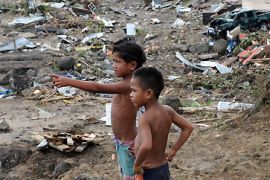
Climate of extremes
Are recent geological disasters man-made and how can nature’s balance be restored?
A series of natural disasters simultaneously hit the world soon after scientists at a major conference in London said that quakes, volcanic eruptions, giant landslides and tsunamis may become more frequent as global warming changes the earth’s crust.
More than 300 people were killed in the Philippines when Typhoon Ketsana struck on September 26.
This week’s Typhoon Parma killed at least 15 people.
Keep reading
list of 4 itemsWorld’s coral reefs face global bleaching crisis
Why is Germany maintaining economic ties with China?
Australia’s Great Barrier Reef suffers worst bleaching on record
Meanwhile, Ketsana moved on to Vietnam claiming more than 120 lives there, and then to Cambodia killing at least 17 people.
On September 29, a 8.3-magnitude earthquake in the South Pacific triggered a tsunami killing almost 200 people in Samoa.
The following day, a 7.9-magnitude earthquake struck the Indonesian island of Sumatra. Over 800 people have been confirmed dead and up to 4,000 people are still missing.
In the last five days, heavy rains in southern India have killed more than 200 people.
In December, delegates from 192 countries will hold two weeks of talks in Copenhagen to establish a new global treaty on climate change.
Are these geological catastrophes man-made? What should be done to reverse the process? And can politicians restore nature’s delicate balance?
Inside Story presenter Shiulie Ghosh is joined by Patrick Michaels, a research fellow at the Cato Institute and author of Climate of Extremes – Global Warming: Science they don’t want us to know, Margareta Wahlström, the special representitive of the UN secretary-general for disaster risk reduction, and John McGrath, a researcher at the Oxfam climate change programme.
This episode of Inside Story aired from Sunday, October 4, 2009.